By Chef Judi Gallagher –
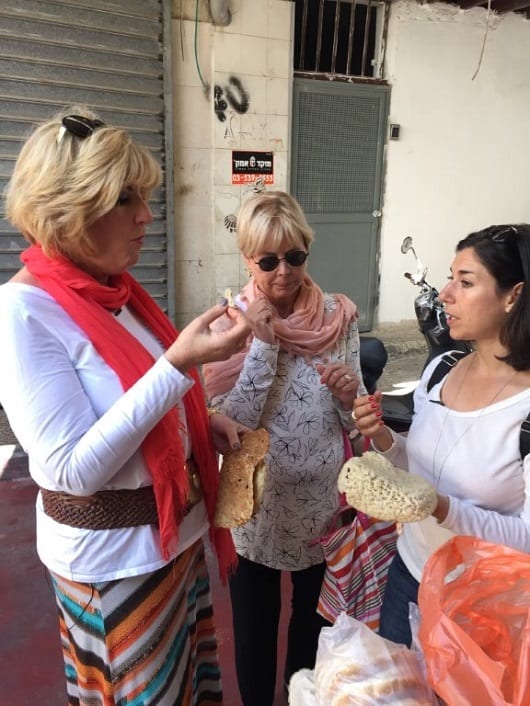 Israeli cuisine is trending. Yes, trending. In a country steeped in tradition where some street and desert scenes seem like a movie set with sculptural dunes and sheep roaming or crowded marketplaces or tiny cafes, Israel is becoming an amazing mix of cuisines. There are Kosher McDonalds spreading across the suburban areas and a pizza shop in the middle of Old Jerusalem, just before you arrive at the Wailing Wall.
Israeli cuisine is trending. Yes, trending. In a country steeped in tradition where some street and desert scenes seem like a movie set with sculptural dunes and sheep roaming or crowded marketplaces or tiny cafes, Israel is becoming an amazing mix of cuisines. There are Kosher McDonalds spreading across the suburban areas and a pizza shop in the middle of Old Jerusalem, just before you arrive at the Wailing Wall.
I learned a new term during a recent journey to Israel. “It’s complicated.” Yes, it is true. Politics are complicated. Traffic in Tel Aviv – definitely complicated. The casual juxtaposition of old and new – also complicated. But one thing that’s not complicated is the food. It’s easy to understand (although the origins of any one dish such as hummus can be tangled) and absolutely wonderful to experience. The food is expressive, exciting, fresh and local. From cured olives to grilled street breads, to eggplants cooked a dozen different ways, Israel is a country that’s creating a new industry –culinary tourism.
 Thanks to the Jewish Federation in our town and a Sarasota, Florida-based organization called Embracing our Differences, co publisher of Flavors & More Marsha Fottler and I were invited to explore Israel though the eyes of chefs, street vendors, religious leaders and young and old citizens. We ate Arabic foods as well as Israeli specialties and sampled recipes both ancient and contemporary. We heard spice grinders humming along as they have for over 100 years at the same location and ate Middle Eastern bread that has been prepared the same way for over a thousand years.
Thanks to the Jewish Federation in our town and a Sarasota, Florida-based organization called Embracing our Differences, co publisher of Flavors & More Marsha Fottler and I were invited to explore Israel though the eyes of chefs, street vendors, religious leaders and young and old citizens. We ate Arabic foods as well as Israeli specialties and sampled recipes both ancient and contemporary. We heard spice grinders humming along as they have for over 100 years at the same location and ate Middle Eastern bread that has been prepared the same way for over a thousand years.
Israel is filled with a wide variety ethnic cuisines, brought with them by Jews immigrating from Yemen, Spain, Germany, France, Iraq and many other lands. Shuks or local outdoor markets in Jerusalem and Tel Aviv are famous for hot and cold foods, fresh-ground spices, cured and fresh meats, fish and so many beautiful vegetables you think you’re at a farm. Juice bars, gelato stands are everywhere. The shuk is the place to find clothing, shoes and crafts as well as fresh saffron or sumac. Sample Peruvian-style ceviches made with local mackerel or fresh pasta layered with baby octopus. Everyone shops at the shuk – homemakers gathering ingredients for the evening meal, those wanting a snack, tourists who taste their their way through a discovery of Israel one bite at a time.
 Tahina, as it is called in Israel, pours from a swirling machine at one stall while next door a new age juice stand promises herbal juices, teas and creams that help with heart diseases, allergies and what they call “men’s issues.” Depending on the sections of the market one visits, you will find the Yemenite quarter and the Jewish Iraqi quarter, and where Azora, a family restaurant has embraced the Italian-born theory of the slow- food movement for over 60 years.
Tahina, as it is called in Israel, pours from a swirling machine at one stall while next door a new age juice stand promises herbal juices, teas and creams that help with heart diseases, allergies and what they call “men’s issues.” Depending on the sections of the market one visits, you will find the Yemenite quarter and the Jewish Iraqi quarter, and where Azora, a family restaurant has embraced the Italian-born theory of the slow- food movement for over 60 years.
At Shuk Carmel in Tel Aviv you will find meat cutters and fish vendors that are somewhat questionable regarding health standards next to a more modern butcher’s showcase owned by a chef and meat cutter from the new generation. We tasted a freshly prepared carpaccio with paper-thin beef, olive oil, gray sea salt and fresh-torn herbs. This was at 10 in the morning and he insisted we have a glass of red wine with it.
And then there is the hummus. World famous hummus. Hummus like you’ve never tasted. Not that store-bought stuff but hummus that is freshly cooked chickpeas whipped together with tahini and topped with hard-boiled egg, olive oil and a spicy red sauce that you dip with a wedge of raw onion or warm pita. Israelis serve fresh fennel salad for breakfast next to cheese babka and pickled salmon. Eggs simmered in red sauce served alongside cucumbers and spinach pies are my kind of breakfast of champions.
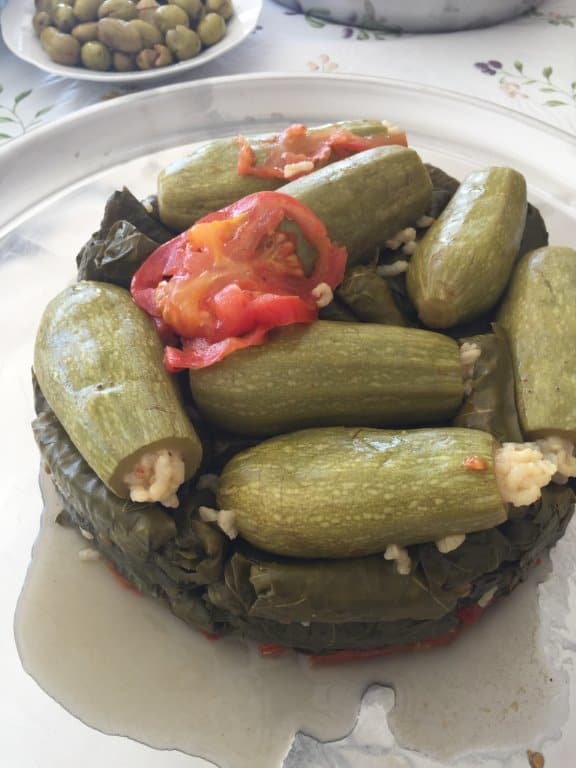 I traveled to the Galilee area to cook with a lovely woman from a small Druze village thanks to the efforts of Galileats, which developed a program for widows to cook for visitors in their own homes to earn extra money. A small group of us (Americans) ate in a home and were served foods that are unfamiliar yet spoke the universal tongues of taste and friendship regardless of the language barrier. She and I cooked together in the afternoon making a rice and tomato dish and stuffed zucchini for the Jewish Federation group that arrived later. There are approximately 120,000 Druze (a religious minority) living in northern Israel. The meal my Druze friend and I cooked is a lasting memory.
I traveled to the Galilee area to cook with a lovely woman from a small Druze village thanks to the efforts of Galileats, which developed a program for widows to cook for visitors in their own homes to earn extra money. A small group of us (Americans) ate in a home and were served foods that are unfamiliar yet spoke the universal tongues of taste and friendship regardless of the language barrier. She and I cooked together in the afternoon making a rice and tomato dish and stuffed zucchini for the Jewish Federation group that arrived later. There are approximately 120,000 Druze (a religious minority) living in northern Israel. The meal my Druze friend and I cooked is a lasting memory.
The grilled rosemary street bread in Israel surprised me. It is warm and soft with a brush of olive oil, coarse salt and fresh snipped herbs. Think of it as Israel’s version of a pretzel stand. There are numerous bowls of starters at a many restaurants. Dishes of slivered beets, hummus, spicy Arabic sauces, tatziki, pickled cabbage salads, falafel and babaganoush. They don’t think of them as small plates but rather a normal way of easing into a long meal.
People grill elaborate meals on an outdoor grill next to the new trendier restaurants that are recreating a modern interpretation of their ancestor’s cuisine. A hybrid of Zabar’s is flourishing in the modern area of Tel Aviv. A real delicatessen, that does not have true Middle Eastern roots but belongs to the traditions of eastern European immigrants.
It is complicated. Litter is a big problem as is graffiti and next to it all near a building that had yet to recover from bombings there permeates the coffee roaster who after training in classical opera returned to operate his family’s coffee roasting business while performing a concert each Friday afternoon.
For the next few months Marsha Fottler and I will continue to share recipes, photos, television segments and connections to the experts if you are planning a trip to Israel.
IsraelExperts: http://www.israelexperts.com/
Galileat: http://www.galileat.com/
Delicious Israel (Inbal Baum): http://deliciousisrael.com/
Druze Stuffed Vine Leaves and Zucchini
2 cups rice, rinsed
1 teaspoon chicken soup powder
1 teaspoon cinnamon
1 teaspoon baharat (see recipe below)
1 teaspoon ground black pepper
1/2 teaspoon dried chili flakes
3 tomatoes
10 ounces minced beef or chicken
1/2 cup olive oil
40 vine leave and 8 small zucchinis
Carefully hollow out zucchinis with a sharp knife or special rounded blade.
Grate 2 tomatoes into rice. Mix in all remaining ingredients except 3rd tomato into rice. Hold 1 vine leaf flat on the palm of your hand. Add 1 teaspoon of rice mixture. Fold in the sides and roll up the vine leaf. Repeat with 35 vine leaves. Cut tomato into pieces just big enough to stuff into the top of a zucchini. Stuff a zucchini with the rice mixture to 2/3 full. Place a piece of tomato into the top of the zucchini as a “cork.” Line the bottom of a pot with reserved vine leaves or sliced tomatoes. Pack rolled vine leaves and stuffed zucchinis into the pot. Fill pot with salted water to cover stuffed vegetables. Place an inverted plate over the vegetables so as to prevent them floating to the top and becoming unraveled. Cover pot. Bring to boil and reduce heat. Occasionally check if there is enough water. Add 1/2 cup of water if necessary. Cook for 40 minutes.
Note: The zucchinis can be cooked separately in water until they just begin to soften. Remove half the water in the pot and fill with good quality, locally produced goat yoghurt. Industrially produced yoghurt may separate upon cooking. To prevent this, add 1 spoon of cornflour, mixed into to the yoghurt before pouring it into the pot.
Baharat
(Druze all-purpose spice)
3 parts allspice
2 parts cinnamon
1 part black pepper
1 part cloves
1 parts coriander seeds
1 part cumin seeds
1 part cardamom seeds
1/2 part ground nutmeg
1/2 parts sweet paprika (optional)
Hot paprika or chile, optional
Mix all ingredients into a spice grinder and grind together. Alternately, buy the spices pre-ground. For best results though, it is best to grind the spices yourself, or go to a spice shop and get the seller to mix and grind on the spot.
F&M






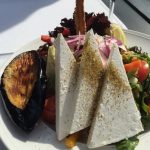

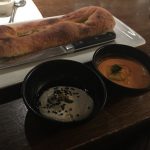
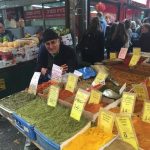

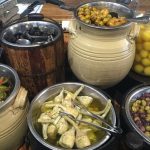


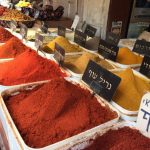


Baharat – a
wonderful spice mix!
We had a cooking/eating experience at Penina’s this winter. Fabulous!